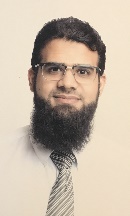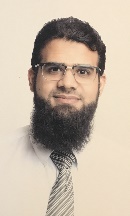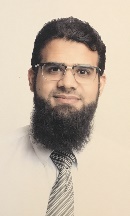Day 3 :
- Pediatric Health
Location: Pediatric Health

Chair
Jamal Ahmed Omer
King Fahad Medical City, Saudi Arabia
Session Introduction
Jamal Ahmed Omer
King Fahad Medical City, Saudi Arabia
Title: Children with medical complexity: A resourceful comprehensive program to a nationwide model of care

Biography:
Jamal Ahmed Omer is a General Pediatrician, Children Specialized Hospital, King Fahad Medical City, Riyadh, Saudi Arabia; he is with a passion and skills in planning comprehensive and comprehensive cares. His open and contextual model of care with help of a highly qualiï¬ed health care team with extensive expertise in area of pediatric complex care is constantly evaluating, planning and structuring the current status of Children with medical complexity (CMC) from multiple national primary and tertiary institutions in Saudi Arabia which is a part of a governmental planning to propose and recommend a model of care to Saudi government as part of the overall national transformation that proposed by our Crown Prince Mohammed bin Salman (vision 2030). His efforts are directed toward building model of care that ensure valuable and high qualiï¬ ed services that is cost-eff ective and responsive to all health stakeholders including patients, their families and administration teams as well as frontline health care providers.
Abstract:
Children with medical complexity (CMC) have medical fragility and extensive care needs that are not easily met by current existing health care models. CMC may have congenital or acquired multi-system diseases, severe neurologic conditions with marked functional impairments and technology dependence for activities of daily living. Although these children are at risk of poor health and impose a huge socioeconomic burden on both families and health system, there are few well-designed clinical initiatives, services and research eff orts devoted to tackle their challenging care, alleviate families and health system burdens or improving overall experiences of either patient’s quality of life or health care providers. Th e burden of multiple chronic diseases is placing pressure on any health care system. As a small but signifi cant population with extensive requirements, these patients present a challenge to healthcare providers who are expected to provide holistic care and manage complex issues oft en with a paucity of experiences, services and supports. Patients with medical complexity and their families need additional sight and help. However, the health care system, community and social services do not always recognize their calls for help or support. Our recommendations are made for health care systems and provider to initiate a valuable service to such group of population to ensure high experienced life. Our comprehensive care program with its research initiative for this valued population aims to identify and recognize the current status of complex pediatric care in Saudi Arabia including the prevalence of children with medical complexity and burden on our health system as well as their families and to accomplish a well-structured model of care with proper services that will enable better understanding of this population and resourceful planning of their extensive and complex care within our health system.
Recent Publications:
1. Fahad A AlFares, et al., (2013) Mycobacterium Bovis pyomyositis of unusual site in 5 months old child: A case report. Curr Pediatr Res 17(2):125-127.
2. Omer J A. Unusual Presentation of Coarctation of the Aorta in a 5-month-old Infant. Pediatr Oncall J. 2017;14: 88-89. doi: 10.7199/ped.oncall.2017.36
3. Omer J A, et al., (2018) Residents awareness about International Patient safety goals, cross sectional study. Arch Pediatr JPED-139.
- Pediatric Cardiology
Location: Augusta Barcelona, Barcelona

Chair
Jamal Ahmed Omer
King Fahad Medical City, Saudi Arabia
Session Introduction
Krzysztof Piotrowski
DIAGEN co., Poland
Title: The genetic aspect of human heart development based on prenatal diagnosis

Biography:
Krzysztof Piotrowski is a Specialist in Clinical Genetics. He has completed his PhD with a dissertation on fetal echocardiography. Putting his knowledge into practice, he performs about 3500 USG investigations of gravidas annually for prenatal diagnosis. He has published many scientiï¬ c papers and chapters covering prenatal diagnosis. For the last nine years he was the Manager of Cytogenetic Unit for Pomeranian Medical University, Szczecin, Poland. Since 2012, he established a new and independent Genetic Center named as DIAGEN co., which includes Cytogenetic and Molecular laboratories. He was the Vice-President of the prenatal diagnosis section of the Polish Society of Human Genetics for six years. He also participated in many investigation programs.
Abstract:
Congenital heart diseases (CHD) are the most common malformations both as an isolated form and a part of genetic syndromes. Extraordinarily fast development of molecular genetics confirms that almost all CHD are genetically dependent in terms of microaberrations in diff erent regions of a chromosome or single gene mutations. On the other hand, CHD are an important component of diverse genetic diseases, including monogenic, metabolic and mitochondrial disorders, most oft en as secondary cardiomyopathies. The genes participating therein are located nearly on each chromosome, mainly on pathways, along with ligand genes and co-factors, transcription factors or individually. Many mechanisms on heart development are based on the balance between apoptosis, proliferation and migration. Crucial genes controlling fetal development, including the creation of heart tube and the forming of left and right ventricular outflow is primary “homeobox” genes grouped in 4 clusters hox1-4. Other genes condition the forming of different structures. The key process for activating consecutive genes is methylation. Methyl groups originate from the metabolic cycle of folic acid, where the main gene is MTHFR. Moreover, in numerous functional disorders, for example the Arrhythmia or block, the reason is also genetic, namely the mutation of ion-channel gene placed in 6 chromosomes. Now we have over 1500 mutations. Many genes of cardiogenesis were identified, thanks to the investigations of other genetic disorders, for example: PTPN11 gene in Noonan syndrome. The gene is also responsible for the development of pulmonary valves. TBX5 gene in Holt-Oram syndrome. Presently the most promising method is NGS technology, where we can perform hundreds of mutations at a time. Heart development is also affected by the imprinting (about 30 genes) and the inactivation of the X chromosome in day 21 stage of embryo. We propose, for e.g. a practical classifi cation could refer to specifi c CHD characteristic of particular disorders, which might prove helpful in daily practice because in prenatal diagnosis CHD is oft en the sole syndrome confi rmed by USG scan, which may depend on truly isolated nature or non-specific mild ultrasound co-markers.
- Dermatology
Location: Augusta Barcelona, Barcelona

Chair
Jamal Ahmed Omer
King Fahad Medical City, Saudi Arabia
Session Introduction
Hossein Yavari
University of Miami, USA
Title: Mohs Micrographic Surgery: Why is the gold standard for non-melanoma skin cancers?
Biography:
Hossein Yavari, MD is specialist in Dermatology and Hair Transplantation Surgery. He is the fellowship of Cutaneous and Mohs surgery from University of Miami, Florida, USA. He is the Diplomate of American Board of Hair Restoration Surgery. He has over ï¬ fteen years’ experience in both Clinical and Cosmetic Dermatology in Dubai and Los Angeles, California, USA. He is the member of American Academy of Dermatology, International Society of Hair Restoration Surgery and the Correspondent Fellow of American Society for Dermatologic Surgery. He has the background of Assistant Professor of Dermatology and the Head of Dermatology Department and currently practices in Dubai and USA.
Abstract:
Biography:
Germaine Escames has broad experience in the studies of the antioxidative role of melatonin and the identiï¬ cation of the mitochondria as the main target of melatonin and its anti-infl ammatory activity against the innate immune response, among others. From several years to date, her activity has been focused on the oncostatic activity of melatonin and the adverse eff ects of radio and chemotherapy. In addition, she studied the eff ects of melatonin on the skin. She has four international patents on melatonin. One is currently under a multicentric clinical trial (in 10 hospitals of Spain) for the prevention and healing of oral mucositis induced by radio and/or chemotherapy and other two patents consist in a endovenous melatonin formulation for the treatment of sepsis. The fourth patent consists in a regenerative and anti-aging cream of melatonin for its topic application in the skin. A clinical trial with this cream to treat position ulcers is now being carried out in collaboration with other groups.
Abstract:
Skin and particularly its epidermal compartment, when exposed to hostile environments such as radiation, physical injury, chemicals, pollution and microorganisms, requires protective chemical molecules and pathways. Melatonin, one of the evolutionarily oldest and most conserved molecules, with well documented direct radical scavenging activity and indirect antioxidant functions, plays a very important role in skin maintenance. The fact that human skin not only has functional melatonin receptors, but also acts as a complete system capable of producing and regulating melatonin synthesis, makes melatonin a promising candidate for maintaining and protecting skin. It is important to note that recent studies have not only discovered how to better synchronize the skin’s circadian clock and to protect skin from external aggressors, but have also provided further evidence that skin barrier functions are predictably time-dependent and that skin chrono-pharmacology also needs to be considered. New metabolic pathways are involved in melatonin’s protective functions in dermal cells. Th e topical use of melatonin for therapeutic purposes and skin protection has considerable advantages. Moreover, endogenous intracutaneous melatonin production, together with topically-applied exogenous melatonin or metabolites, is expected to be one of the most potent antioxidative and anti-infl ammatory systems of defence against external damage to the skin. Therefore, melatonin could be used therapeutically in future clinical dermatological treatments and also in preventive medicine strategies.
Recent Publications :
1. Slominski A Fischer TW, Zmijewski MA et al., (2005) On the Role of Melatonin in Skin Physiology and Pathology. Endocrine 27: 137–148.
2. Slominsk A, Tobin DJ, Zmijewski MA et al., (2007) Melatonin in the skin: Synthesis, metabolism and functions. TRENDS in Endocrinology and Metabolism 74:3913-3925.
3. Shen YQ, Guerra-Librero A, Fernandez-Gil BI et al., (2017) Combination of melatonin and rapamycin for head and neck cancer therapy: Suppression of AKT/mTOR pathway activation and activation of mitophagy and apoptosis via mitochondrial function regulation. J Pineal Res doi: 10.1111/jpi.12461.
4. Abdel Moneim AE, Guerra-Librero A, Florido J et al., (2017) Oral Mucositis: Melatonin Gel an Eff ective New Treatment. Int J Mol Sci. doi: 10.3390/ijms18051003.
5. Fernández-Gil B, Moneim AE, Ortiz F, Shen YQ et al., (2017) Melatonin protects rats from radiotherapyinduced small intestine toxicity.PLoS One. doi: 10.1371/journal.pone.0174474.
Doaa A. Zaky
Cairo University, Egypt
Title: Novel gut barrier modulatory effect of Vildagliptin in amelioration of bacterial translocation in cholestatic rats.
Biography:
Doaa A. Zaky has completed her MBB CH of Medicine and Surgery from Ain Shams University in 2002 and also completed her MD in Tropical Medicine form the same university in 2010. She has a Professional Diploma of Clinical Nutrition from National Nutrition Institute. Her ï¬eld of interest includes, Infectious Diseases and Tropical Medicine, Gastroenterology and Hepatology and Clinical Nutrition. She is also working as a researcher in the team of stem cell research in Ain Shams University, Egypt.
Abstract:
Intestinal barrier dysfunction is frequently implicated in the etiology of septic complications following obstructive jaundice. Th e present study was conducted to investigate the potential gut barrier modulating effect of Vildagliptin (VLD), a dipeptidyl peptidase-IV (DPP-IV) inhibitor, on common bile duct ligation (CBDL) in rats. VLD (10 mg/ kg/d; p.o) was administered for 10 successive days aft er CBDL in male Sprague-Dawley rats. VLD reduced portal endotoxemia induced by CBDL and suppressed rectal temperature elevation, body weight loss and colon and spleen indices to diff erent extents. Moreover, it reversed villous blunting, low villous density, mucosal thinning and infl ammatory cell infi ltration noticed microscopically in the ileal segments of the CBDL rats. Th ese events were accompanied by the reduction of intestinal myeloperoxidase activity and lipid peroxidation, the elevation of the major anti-oxidant molecule, glutathione, as well as the normalization of ileal nitric oxide level. Furthermore, ileal DPP-IV was inhibited in association with the rise in ileal glucagon-like peptide-1 (GLP-1) and insulin-like growth factor-1 (IGF-1) levels in VLD treated animals. Th e current fi ndings suggest that VLD anti-oxidant, antiinfl ammatory, as well as enhancements of incretin and IGF-1 account for the hardwearing of the intestinal barrier that functions competently in the absence of the supporting bile elements.
Doaa A. Zaky
Cairo University, Egypt
Title: Novel gut barrier modulatory effect of Vildagliptin in amelioration of bacterial translocation in cholestatic rats.
Biography:
Doaa A. Zaky has completed her MBB CH of Medicine and Surgery from Ain Shams University in 2002 and also completed her MD in Tropical Medicine form the same university in 2010. She has a Professional Diploma of Clinical Nutrition from National Nutrition Institute. Her ï¬ eld of interest includes, Infectious Diseases and Tropical Medicine, Gastroenterology and Hepatology and Clinical Nutrition. She is also working as a researcher in the team of stem cell research in Ain Shams University, Egypt.
Abstract:
Intestinal barrier dysfunction is frequently implicated in the etiology of septic complications following obstructive jaundice. Th e present study was conducted to investigate the potential gut barrier modulating eff ect of Vildagliptin (VLD), a dipeptidyl peptidase-IV (DPP-IV) inhibitor, on common bile duct ligation (CBDL) in rats. VLD (10 mg/ kg/d; p.o) was administered for 10 successive days aft er CBDL in male Sprague-Dawley rats. VLD reduced portal endotoxemia induced by CBDL and suppressed rectal temperature elevation, body weight loss and colon and spleen indices to diff erent extents. Moreover, it reversed villous blunting, low villous density, mucosal thinning and infl ammatory cell infi ltration noticed microscopically in the ileal segments of the CBDL rats. Th ese events were accompanied by the reduction of intestinal myeloperoxidase activity and lipid peroxidation, the elevation of the major anti-oxidant molecule, glutathione, as well as the normalization of ileal nitric oxide level. Furthermore, ileal DPP-IV was inhibited in association with the rise in ileal glucagon-like peptide-1 (GLP-1) and insulin-like growth factor-1 (IGF-1) levels in VLD treated animals. Th e current fi ndings suggest that VLD anti-oxidant, antiinfl ammatory, as well as enhancements of incretin and IGF-1 account for the hardwearing of the intestinal barrier that functions competently in the absence of the supporting bile elements.
